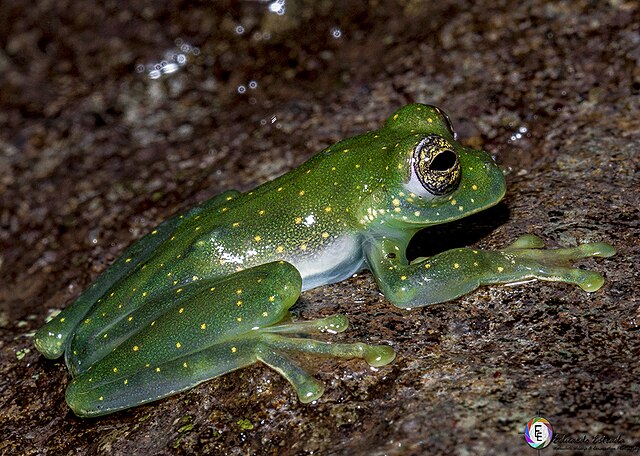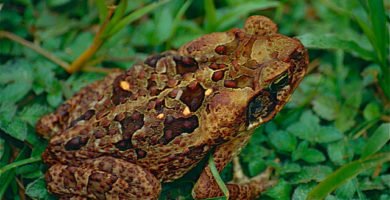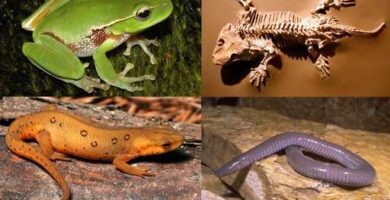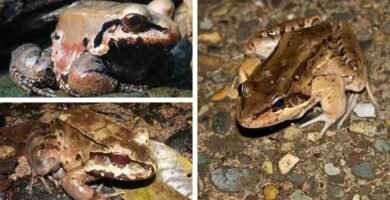
Characteristics, reproduction, geographical distribution. Other types of frogs and toads of the Amazon.
The glass frog (Hyalinobatrachium spp.) is a small forest-dwelling tree frog belonging to the family centrolenidae, a monophyletic group.
Such a group occurs when all the organisms it includes have evolved from the same ancestral population. It is, therefore, a group of Neotropical anurans that are widely distributed from southern Mexico to the south of the Brazilian Amazon and northern Argentina, passing through the territories of the Guiana Shield and the northern Amazon, which includes the areas of Venezuela, Colombia and the Guianas.

Author: EEStradawildphoto CCBYSA
Characteristics of the glass frog
We find the centrolenidae family in the vast Amazon River basin. They look alike, with the particularity of having some special feature that distinguishes them. In the case of the glass frog, the feature is its transparency or crystalline appearance.
In Venezuela, 25 species have been reported. Among them, at least 15 species belonging to the genus Hyalinobactrachium have been described (Señaris, Ayarzagueña 2001).

Geoff Gallice from Gainesville, FL, USA CC BY
Members of this family have various skin colors, predominantly green. They are poisonous frogs. Some species have visible organs, because their belly skin is transparent. In some cases, several of its internal organs can be clearly seen: the heart, stomach, liver and intestines.
Amazon transparent frog
Some 48 species of glass frogs have been reported in the Ecuadorian Amazon (Borjas 2009), some inhabiting forest ecosystems located in the basin of the Napo, Pastaza and Santiago rivers (Yánez-Muñoz, Meza-ramos, Ortega-Andrade, Mueses, Cisneros, Reyes-Puig, Dusan 2010).
One of the latest species described, perhaps the most spectacular among all those already known, is Hyalinobatrachium yaku, which stands out for having dark green dots on the head and dorsum of the body.
It also has a transparent belly, a common characteristic present in all frogs of this genus, but which in this species extends to the pericarp, the membrane that surrounds the heart. This is why the red color of the blood and its circulation can be observed in the body of this glass frog.
This species was found in three lowland areas of the Ecuadorian Amazon, located between 300 and 360 meters above sea level. The frog emits a song of high vocal tones, of an unusually long duration of forty seconds.
Reproduction of the glass frog
The males take care of the eggs, hiding them under dry leaves until they hatch. And then they are released (Bustos-Gordón 2019).

Their enemies are the heavy deforestation in the Amazon region, aggravated by the growing colonization of new areas and the opening of new roads, causing the fragmentation of the forest continuity, making its mobility difficult.
Other types of Amazonian frogs and toads
November 17, 2019

Cane Toad / Giant Toad (Rhinella marina)
November 17, 2019

Kambo (Phyllomedusa bicolor)
October 5, 2019

Amazon Rainforest amphibians: toads, frogs (anurans), salamanders and caecilians
Bibliography
- Borja M.O. (2009). Ecological niche modeling of glass frogs (Amphibia: Anura: Centrolenidae) of Ecuador from museum records: prediction of area of occupancy and evolution in relation to the National System of Protected Areas of Ecuador. Thesis. College of Biological and Environmental Sciences. San Francisco de Quito University.
- Bustos-Gordón M. (2019). Reproductive ecology of Hyalinobatrachium chirripoi (Taylor 1958) (Anura: Centrolenidae) in the Itapoa Reserve, Esmeraldas Province, Ecuador. Degree work. Biological and Environmental Sciences. Quito: UCE.
- Cardozo-Urdaneta A., Celsu Señaris J. (2012). Vocalization and reproductive biology of the glass frogs Hyalinobatrachium pallidum and Centrolene daidaleum (Anura, Centrolenidae) in the Sierra de Perijá, Venezuela. Memoria de la Fundación La Salle de Ciencias Naturales, Caracas, 173-174, 87-105.
- Celsu-Señaris J., Ayarzagueña J. (2001). A new species of glass frog of the genus Hyalinobatrachium (Anura: Centrolenidae) from the Orinoco Delta, Venezuela. Revista de Biología Tropical, Vo.49 (3-4), San José, December.
- Guayasamín J.M., et al. (2008). Phylogenetic relationship of glassfrogs (centrolenidae) and nuclear base don mitochondrial genes. Molecular Phylogenetic and Evolution, 48, 574-595.
- Yánez-Muñoz M.H., Meza-Ramos P.A., Ortega-Andrade M., Mueses-Cisneros J., Reyes-Puig M.M., Reyes-Puig J.P., Dusan J.C. (2010). Reyes-Puig J.P., Dusan J.C. (2010). New data on the distribution of Rana de Cristal (Amphibia: Centrolenidae), in eastern Ecuador, with comments on the diversity in the region. A.C.I. Advances in Science and Engineering, Vol. 2 (3).
July 7, 2020

Smoky jungle frog
April 30, 2020

Poison Dart Frog (Phyllobates terribilis) – The most powerful poison in the world

Dr. Rafael Cartay is a Venezuelan economist, historian, and writer best known for his extensive work in gastronomy, and has received the National Nutrition Award, Gourmand World Cookbook Award, Best Kitchen Dictionary, and The Great Gold Fork. He began his research on the Amazon in 2014 and lived in Iquitos during 2015, where he wrote The Peruvian Amazon Table (2016), the Dictionary of Food and Cuisine of the Amazon Basin (2020), and the online portal delAmazonas.com, of which he is co-founder and main writer. Books by Rafael Cartay can be found on Amazon.com
This post is also available in:
![]() Español (Spanish)
Español (Spanish)
